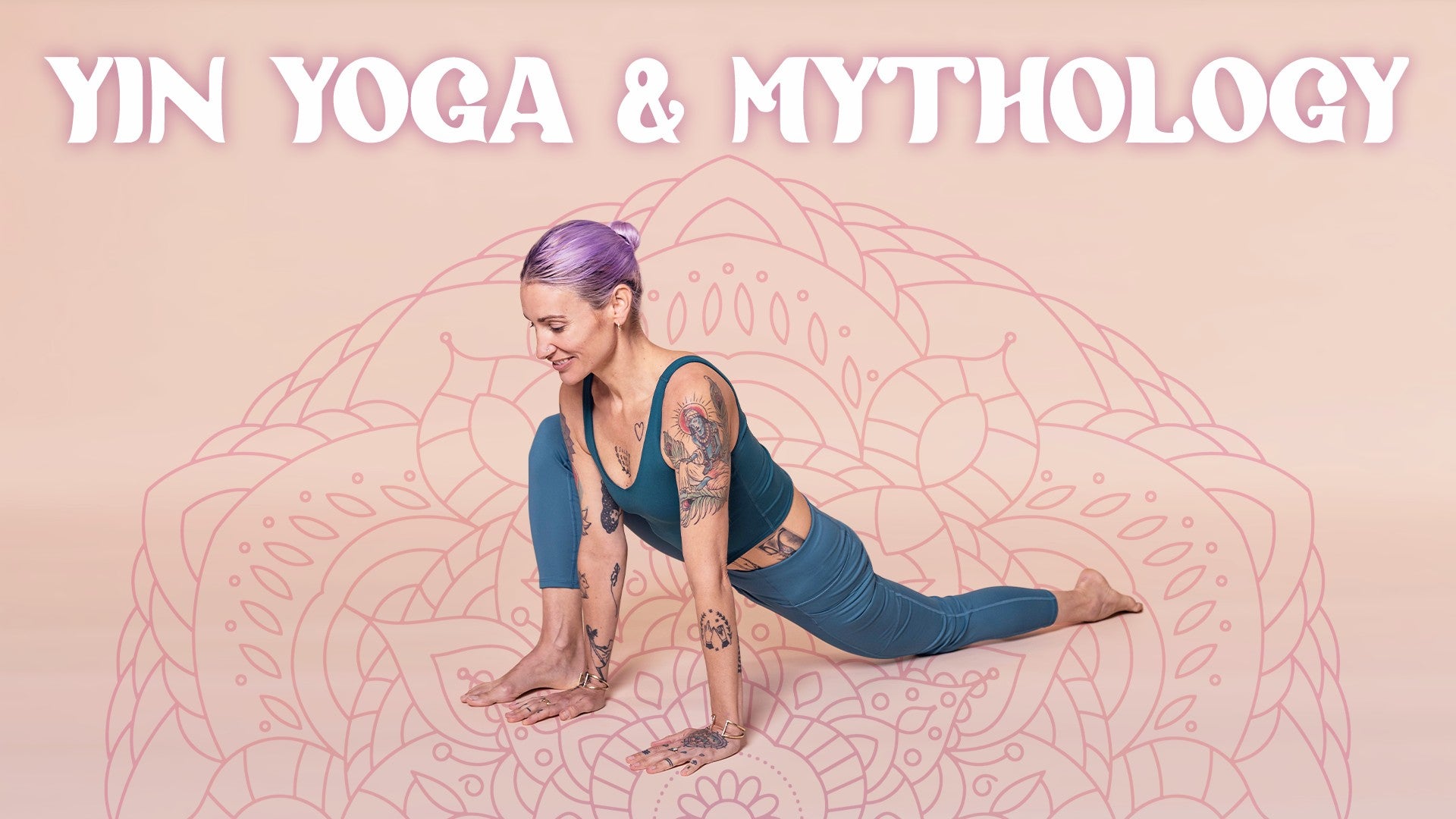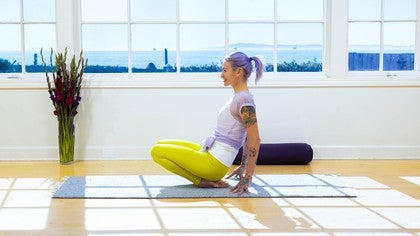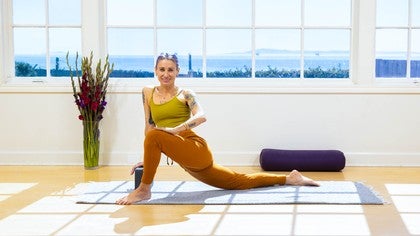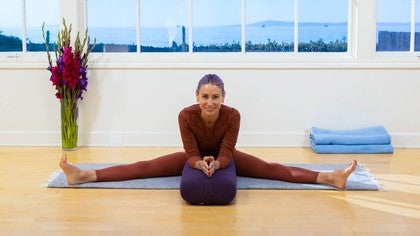Description
About This Video
Transcript
Read Full Transcript
Welcome. Thanks for joining me. I'm Kelly Cam, and I've got my wild neon pants on today because we're going to talk about a wild goddess. Today's class is inspired by the goddess Kali, and Kali is often mistaken as the goddess of death, but in fact, she's the goddess of time and destruction. And so we're going to get into some interesting discussion as we sink into some of these yin poses today. We'll begin in toes pose. And for that one might be nice to have a bolster nearby. I'll show you two options with a bolster or a pillow if you don't have a bolster and without. So the toes are curled under. And if you're using the bolster or the pillow, you can lean your knees on the support at any point if you need to, if it becomes too much, you can lift your hips up off of your heels, or you can lean forward onto your hands to take some weight off of your feet. If you're not using the support of a bolster or a pillow, you can do it without toes, same way, toes curled under, hands resting anywhere that they're happy on your thighs or on your body. And we'll just take a couple of minutes in this shape to start perhaps playing with the idea of respecting discomfort. Cultivating a new relationship to awkwardness or discomfort in our life can be really helpful. So I encourage you, I know it gets a little bit intense this pose sometimes as time passes, but I encourage you just to sink in to lean in and to try your best not to steal yourself against the feeling, the sensation that you have, but to see if you can live with it, to see if there can be room in you for both a little bit of discomfort, but also some ease. Can they live together in the same place, in the same shape, in the same body? Just a couple more breaths. Then to come out of this one, go ahead and walk out onto your hands, on curling your toes, and as you set the feet back down, this time you're on the tops of the feet. And for many people, just to sit on the tops of the feet like this is enough to find a good counter pose and a stretch across the ankle, but if you want a little more, you could even lean back, leaning onto your hands behind you. And perhaps this is just a maybe, but perhaps lifting the knees up any amount, even an inch is plenty. And this is just a lovely counter pose after that toe stretch to get a nice relief, a nice stretch across the ankle. And also practicing here too, a little bit of discomfort, learning how to live with that. And then we'll let it go and we'll come down onto our bellies for a broken wing. So working with some shapes today that might put us into places that we have to work on, just developing a sense of ease in the midst of something that might feel a little chaotic or a little bit difficult. So I have my right arm stretched out, left arm beside me by my chest, going to bend the left knee and just roll right over onto the right edge of the body to place my left foot behind me. Okay. And it can go anywhere. And if you need to, you can definitely keep your knees stacked and lie on your side like this, but I'm going to step the left foot behind me. The left hand can stay on the floor in front of you. I'm going to rest mine underneath my head so that I can still talk to you and you can hear me. You can make any little adjustments with your right arm that feel nice to you. You might scoot it a little further away from you or even a little further up or down, finding just the right spot to land where you feel something, but it's sustainable. In yin, we definitely want to have some sensation in each of these shapes, but not so much that you need to jump out or that it's unbearable. I mean, just enough that we're living with a little bit of awkwardness, living with some sensation, but we can stay here for a bit. So Kali, our muse for today, Kali, the goddess of destruction, she looks really terrifying. She's got fangs that are dripping with blood. She's got wild matted hair. Her skin hangs from her bones. She wears a necklace of skulls and a skirt made of severed arms. And I know all of that sounds pretty outrageous, but it all serves a purpose, this iconography of hers. It's all meant to sort of shake us up, get us out of our ordinary, everyday thinking. It's also meant to point us to the idea that perhaps the divine, whatever we think of as the divine or a higher power or God or love, that it doesn't always show up as rainbows, puppy dogs, and all sweet and beautiful things. Sometimes the divine shows up and it's a little bit scary or even a lot scary, but it's got our best interest at heart, sort of like tough motherly love. So settling in for a few more moments here, just noticing any resistance, any place that you feel defensive, where you might be able to drop that, what would it be like to be here undefended and leaning in to any discomfort or awkwardness? Coming out, you can slowly fall back onto your front side. You could feel nice here just to stay still. I'm going to pillow my hands to rest the forehead, or you might windshield wiper your legs, just washing the feet side to side.
In these in-between moments, if your body craves anything else, you're welcome to improvise. Everything I say is a suggestion that you can interpret as you need to. So we'll head over to the other side. As you feel ready, you can drop the legs if they were windshield wipering and extend the left arm straight out from the shoulder to the left side. Right hand comes next to the chest, bending your right knee with the right hand, gently push yourself over onto the left edge of your body. Your right foot can step behind you, finding just the right place to land. Don't be afraid to fidget a little bit until it feels right. Same thing with the left arm. You can move it up, down, in, out until you find just the right place to land. Then finding the suggestion of stillness and sinking in.
Sinking in and back to Kali we go. So Kali's terrifying looking, very wild, very primal. And her story, how she came to be, is a really good one. It starts actually with a demon. And this demon had this magic power that any time someone cut him, the blood that was spilled would turn into a thousand more demons. And so he was pretty much invincible, or so he thought. No one could defeat him because every time they tried, more demons would be created. So the gods and the goddesses got very frustrated with this.
In particular, the goddess Durga got really upset. But instead of freaking out, instead of yelling and screaming, she sat down. She meditated. She closed her eyes. She dropped in. And then her third eye opened. And when Durga's third eye opened, Kali came jumping out of it. With her hair flying wild, her eyes rolling in their sockets. And her tongue, her tongue rolling out of her mouth, the biggest tongue anyone had ever seen. Checking in with your own body for a moment. Again, looking around for anywhere that feels defensive, tight or sharp. I'm just trying to remind yourself that you're safe here. You can let go a little bit.
Take another breath. Let the exhale be long and soft and slow. And then begin to roll back onto your front side. As you transition out, you could gather your arms back in to rest your head on, bend your knees, wash the feet from side to side. And most slowly come on up to kneeling. But do take your time. There's no hurry. So as you come to kneeling, we'll play a little bit with some moving shapes, going from a gentle camel to a child's pose with arms crisscrossed. So for the camel standing on your knees, your hands almost like they're in your back pockets, and any amount of lifting the chest and arching back. We're not going for anything extreme because we want it to be sustainable. We want it to be that you could live here for some amount of time. If it's not comfortable to have your head back, your head could always be neutral or even drop just kind of interesting. We won't be here too long. Another breath is good. And then when we come out of it, come to a child's pose here. So big toes a little closer, knees a little wider. I'm going to cross my arms one in front of the other just noticing which arm is on top to fold into a crisscrossed child's pose. Or if you wanted to, you could always pull your bolster in or your pillow to rest your head on. I'm just going to let mine drop. So we're going to move in and out between these poses, repeating them a few times. So as you come up and come up and back into that camel, bringing your hands to your back. If you feel so inspired, some of you might want to hold on to your feet and take a camel like that, but just encouraging you to always stay maybe a little more gentle than you're inclined to. So a little bit of back bending, a few breaths here, and you can even go at your own pace. I know if you feel like you need to come out sooner, please do. Or if you're really loving it and it's interesting and you want to linger, that's great too. And then when you do come out, it's that child's pose with the arms crossed again, the other arm in front.
So Kali jumps out of Durga's third eye and unrolls her tongue across the whole battlefield. I'm coming up for another camel. I'm going to repeat this two more times. So two more camels, two more child's poses. If you release camel, the arms crossed in front of you for child's pose. So she unrolls her tongue, covers the battlefield with her tongue, and then gives the signal for all the other gods and goddesses to charge the demons. Coming up for one last camel here, standing on your knees. Any amount of backbend that feels good, sustainable. Last time, child's pose with arms crossed. So she unrolls her tongue and all the other gods and goddesses start to go after the demons, the many demons that are there now. And they slay the demons one at a time. And each time they do, whenever they cut the demon, the blood that falls, instead of falling on the ground, it lands on Kali's tongue. So Kali drinks all the blood, all the darkness from the demons, so that not one drop spills on the earth to create more demons. So as you come out of child's pose here and uncross the arms, we're going to head into a saddle pose. And for that, it could feel really nice to have a bolster. So I'll show you two options. I'll show you saddle pose, and I'll show you another shape that would be just as wonderful, because not all bodies love saddle pose. So you can decide for yourself if this is right for you. So you're sitting on the heels. The knees can be slightly wide or even a bunch wide. And then the bolster comes right up against you and very carefully starting to walk back. And maybe it's even enough just to be right here. There could be lots of sensation going on right here. But if you do want to feel a little bit more, get lower down, whole back spine, head on the bolster, the arms can go anywhere. They're happy, truly anywhere is welcomed. And then I'll just show you the option for those who might not want to do saddle pose. You could still use the bolster, just turning it sideways and bringing it underneath the sacrum with the legs outstretched. So in both shapes, saddle and this one, which we call pontoon, you're getting this opening across the hips through the psoas, tops of the thighs, low belly. So I'll be in saddle while I tell you the rest of the story. So you can go ahead and settle in, let your skin soften, your muscles loosen off the bone, your bones be nice and heavy. So Kali is the one who saves the day by essentially drinking the darkness. And so it's kind of what she does for us as well. You could think about her taking away whatever's dark, whatever's painful, whatever holds you back, whatever keeps you stuck in your life. You could invite Kali in to come and drink it to take it away. And what I love about Kali is that, you know, there's nothing too dark, there's nothing that, you know, too uglier. The things we think are wrong about us, the things we think are ugly about us, you know, you can bring it all to her. There's no judging. She'll take away anything without any judgment.
So Kali is this goddess of destruction, but she's also the grace, the wisdom that comes after it. I wonder if you can think about or remember a time in your life when it felt like things were falling apart and it felt scary maybe, maybe even terrifying. Might have been a time when you lost something you thought was really important. You know, we lose jobs, we change partners, our life shifts all the time. And sometimes those transitions are challenging, they're hard. But when we look back on it, it was definitely for the best, right? Often those painful things are exactly what we need to grow up. So as you're in the shape here, just notice wherever you feel the sensation the strongest. And notice your reaction to it. Do I hesitate? Do I defend? Do I want to run away?
Or can I be with it? Can I live with a little bit of discomfort? Or can I make friends with it and even respect it? Hmm. And these last few moments, really allowing yourself to sink in and spread out, finding an inner and an outer uncoiling. And then calling yourself back little by little. So if you're on the bolster in saddle pose, you could use your elbows and then your hands to help yourself up.
Try to let the head be the last thing to come up. If you're in the pontoon with your legs out stretched, you could bend your knees, put your feet on the floor and lift your hips to take the bolster out. So I'm going to move the bolster out of the way so that I've got lots of room on the mat now to come to a forearm plank, which I know might be surprising in a yin practice. You could always do it on your knees for sure, but I'm going to clasp my hands, plug my forearms into the ground, tuck my toes under, and lift the knees to take this really strong shape. And it's another shape that isn't maybe always our favorite. Kind of hard to talk in it, but a really good one for teaching us that we can do hard things. At any point, if you need to rest, you could always put your knees down or come all the way down.
But we're going to try to stay a couple more breaths. If you're interested in that, you can always come down and come back into it. And just really learning how to show up and be in places that might feel a little sticky, a little challenging. And you know, know that we can do this. We can do hard things. And then letting it all soften down, the knees coming down, toes uncurling, whole body coming down to the ground, just for a moment. And we'll transition into a child's pose. Simple child's pose, knees can be any amount wide. If you want to use props, that's always welcomed. You could pull in some pillows or a bolster underneath you, or you could keep it simple. I'm going to keep it simple for today.
So coming into this child's pose and just settling, maybe calling to mind some battle that you faced in your life. Remembering some difficulty that you thought at the time, why is this happening to me? Or I'm never going to get through this. Things will never be the same. And then what happened? You got through it, right? Can you think of some moment in your life where things got really shaken up, maybe you lost something or someone that was really important to you. And can you look back on it now with perhaps a little bit of gratitude because it made you who you are. All these battles, all these struggles, often they're just what we need to wake up, to become wiser and stronger.
So can we learn perhaps to even look forward to things falling apart to a little chaos and destruction? Because after the storm is over, we won't be the same. And that's a good thing. We'll be better for it. Look for any resistance in your body. Scan yourself top to bottom, bones to skin. And just look for any gripping, holding, tightening. And invite gravity in to help you loosen. Imagine every drop of you sinking and spreading out.
So in these last few moments, imagine your bones falling apart. So if your bones could all loosen from each other, and in the spaces between the bones, the breath could move like wind, like wild wind, sweeping your joints clean. Begin to crawl your hands back, lifting your torso up. Coming back, and we'll turn around for a little shavasana, resting in the unknown, resting in the in-between. Because aren't we always in some sort of transition in our lives? And could we rest and be okay with things not being all tied up in a nice bow? Could we rest and maybe even love or enjoy a little bit of wildness and uncertainty in our lives? A little bit of things being shaken up. Because that's how we grow. If we always stayed the same, that'd be pretty boring, I think.
So let your body rest, let your bones rest, let your heart rest, let your mind rest. Hmm. Mm-hmm. Mm-hmm. Beginning to stir, you could blink your eyes a few times.
You could wiggle your fingers, toes. So you're welcome to stay in a longer shavasana. Otherwise, you can begin to call yourself back a little blink of the eyes, a little twinkle of the fingers, a shake of the toes. Any movement that helps you emerge, climb back from the depths. You could stretch, you could hug, curling up on either side. Pick your favorite side to roll onto and press your way back up to sit. And as we come to sit, we'll finish practice today with a mudra. This mudra is called kalashvara. You take the backs of your middle fingers to touch and all the other fingers touch at the tip. So I'll show you in all directions there. It looks like a heart when you look at it straight through. Bring that right in front of the body by the heart or by the navel. Let it be a reminder that, you know, the divine isn't always all rainbows. That sometimes blessings show up in unexpected packages. And sometimes the things we think are the very worst thing to happen to us turn out to be the best thing to happen to us. So may we respect or perhaps even look forward to and delight in messy moments of change.
And you could bring your palms together in a prayer. And I thank you so much for joining me. And I wish you ease and grace through your messy moments of change. Thank you.
Yin Yoga and Mythology
Comments
You need to be a subscriber to post a comment.
Please Log In or Create an Account to start your free trial.




















